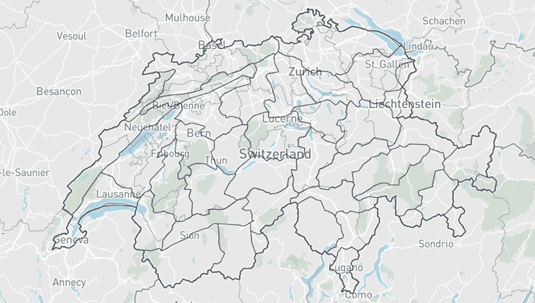Warnings and recommendations for action in the case of drought
Drought refers to exceptional, climatologically unusually dry conditions that pose a challenge for the authorities, sectors and ultimately the general public. They are not to be equated with dry periods that are climatologically usual for a season or a particular region.
As for other natural hazards, official warnings are issued so that affected authorities and sectors can prepare for an impending drought in good time. These warnings, issued per region, are based on the weekly expert assessment of the current situation and the combined drought index forecast. They differ from the automatically calculated CDI in that they interpret trends and take into account forecast uncertainty.
The drought hazard levels issued for each region are explained below. They are based on the hazard levels specified in the Civil Protection Ordinance (Art. 24)
Hazard level 1 (green): No or low danger
Explanation:
Normal situation. There is little or no risk of a prolonged drought developing over the next four weeks
Impacts:
No (significant) impact.
Action required:
No special measures are required to prevent drought occurring. Annually recurring or locally ordered water-saving measures may still be imposed.
Description of measured and forecast values
The combined drought index for the coming weeks does not deviate significantly from the long-term average for several variables (precipitation, discharge and soil moisture).
Hazard level 2 (yellow): Moderate danger
Explanation:
There are signs of a prolonged drought. The situation may get worse. (Initial) impacts and restrictions are to be expected.
Impacts
-
- Water bodies: Water levels in watercourses and lakes are likely to be lower than usual; below-average groundwater levels and spring discharges are possible; in summer, water temperatures are higher than usual for the time of year; restrictions on water use may be imposed locally.
- Agriculture: Local soils are dry, which may lead to crop failure.
- Water supply: Water demand may exceed the available resources in the local area.
- Water protection/fisheries/industry/use of cooling water: No (significant) impact.
- Forestry: An increased risk of forest fires is to be expected.
- Shipping: It may be necessary to reduce the maximum payload for vessels on the Rhine.
- Hydropower: There may be a slight reduction in output at run-of-river power plants.
Action:
-
- Find out about the current situation in your region at www.drought.admin.ch.
- Find out about any restrictions on water use that may be in place.
- Use water sparingly.
Description of measured and forecast values
The combined drought index for the coming weeks deviates significantly from the long-term average for several variables (precipitation, discharge and soil moisture).
Hazard level 3 (orange): Considerable danger
Drought warnings are only issued at hazard levels 2 and 4.
Hazard level 4 (red): High danger
Explanation:
Hazard level 2 has already been reached and forecasts indicate that the situation is likely to deteriorate significantly. There are considerable impacts and restrictions at this drought level.
Impacts:
-
- Water bodies: Individual sections of small watercourses are likely to dry out. This could also happen in medium-sized watercourses; smaller springs may dry up. There may be less water in larger springs; in summer, the temperature limit of 25 °C may be exceeded in some stretches of rivers and streams; restrictions on water use are likely at local or regional level, and bans may be imposed.
- Agriculture: Local soils are very dry, which is likely to lead to crop failure.
- Water supply: Water demand may exceed the available resources in local or regional areas; restrictions are possible for certain uses.
- Water protection/fisheries/industry/use of cooling water: The cooling capacity of production and power generation systems may be limited; unusually high water temperatures may be reached in individual stretches of water, causing problems for aquatic organisms.
- Forestry: An increased risk of forest fires is to be expected.
- Shipping: There may be restrictions for vessels on rivers and lakes; the maximum payload of Rhine vessels is likely to be severely limited.
- Hydropower: There may be a reduction in output at run-of-river power plants.
Action:
-
- Find out about any instructions issued by the local authorities regarding bans and restrictions on water use and observe them.
- Use water sparingly
- Follow instructions and observe any bans issued by the local authorities regarding the risk of forest fires
Description of measured and forecast values
The combined drought index for the coming weeks deviates considerably from the long-term average for several variables (precipitation, discharge and soil moisture). An event of this magnitude happens only a few times in 50 years in this region at this time of year.
Hazard level 5 (dark red): Very high danger
Drought warnings are only issued at hazard levels 2 and 4.
General comments on warning strategy:
Hazard level 2 is primarily intended to alert the authorities and affected sectors. These should then observe the situation and put any necessary measures in place. The general public is informed that the cantons and/or communes may introduce restrictions.
Hazard level 4 is intended to warn the general public that there is a drought situation with considerable impact. At this level and above, the public can expect to be directly affected by restrictions (e.g. on water use) imposed by the cantons and/or communes.
Hazard levels 3 (considerable risk) and 5 (very high risk) are not used for drought, as they do not impact the public additionally to levels 2 and 4.
Further information and the current hazard situation (all natural hazards) can be found on the Confederation’s .
Warning regions:
Drought warnings are issued for 38 regions in Switzerland (see illustration). The warning regions are based on the existing federal warning regions, as used, for example, in severe weather warnings and regional flood warnings.

The 38 regions for which drought warnings are issued.
Links:


